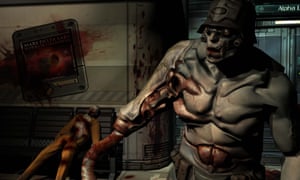his was how it happened for me, and I guess for a lot of people at the time. In 1993 I was working part-time at a game development studio while studying English and Drama at Warwick university. The studio, Big Red Software, was five guys in a small office above a printers in Leamington Spa. We ate, drank and breathed video games. If we weren’t making them, we were playing them. One day, we got Doom working across the office computer network. It meant that we could play together, co-operatively. That was 10am in the morning. We played for 16 hours straight. When I got outside, I saw every garage door as a potential demon entry point.
Today, More than 20 years later, Id Software is releasing a new version of Doom. It is throughly updated, with high-end visuals and contemporary design sensibilities – early word is that it’s a successful modernisation. But it can never do what Doom did back then. There had been other first-person games before it – Id itself made the Wolfenstein titles. But for this game, the brilliant coder John Carmack built a new engine, capable of rendering more complex environments in 3D. Well, sort of 3D. The maps themselves were 2D, and there was no vertical camera movement. Everything happened on a fixed plane.
It didn’t matter – in fact, it’s part of the game’s brilliance. Doom is utterly stripped back and purposeful. No pixel is wasted. Although the creative director, Tom Hall, wrote an exhaustive backstory for the game – about space marines arriving at a base on the Martian moon of Phobos to find it over-run with demons – the other leading members of the team, John Carmack and John Romero, hacked it all out. The story is only ever hinted at, and all human detail is ripped from the locations. These are spaces of death and horror; they are in service only to the core experience of the game: blasting the shit out of everything else.
In January 1976, the Ramones gathered in the Plaza sound studio in New York and over the course of a week, on a budget of $6,400, they recorded an album that distilled the essence of the burgeoning punk rock movement – the anger, the energy, the aesthetics – into one perfect slab of vinyl. In this way, it changed the course of popular music. It felt dangerous and provocative.
A game for kids who felt disenfranchised and frustrated
Similarly, Id Software tuned into1990’s teenage cultural ephemera, and scared parents and politicians in the process. Drawing influences from death metal, the Evil Dead movies, HR Gieger and Aliens, the team created an insular and furious experience. The walls are slime-splattered screaming faces, there are dismembered bodies, the demons stomp and spit and explode into guts. It was like being in a super dark music video or Dario Argento splatter flick. The tinny soundtrack, a mechanised take on metal, tapped into the rise of industrial music – and like that music, Doom was a gift to those of us who felt disenfranchised and frustrated.
The design was brilliant. These weren’t linear corridors like Call of Duty – the Doom maps were large maze-like constructions where players were forced to explore and backtrack to find colour-coded keys and progress onwards. You scurry about, collecting ammo and health, then prepare for the inevitable burst of demons whenever you enter a new room. The monsters come at you like rioters. As with the first Ramones album much of this was produced quickly, in a burst of creativity. Romero and fellow designer Sandy Peterson were pushing out new levels on a daily basis – and these levels were astonishing: great cathedrals of destruction, in which small steps and corridor twists were expertly employed to create a sense of separate areas.
Doom set the tone of first-person shooter weaponry. The shotgun, the chaingun, the BFG – the feel was perfect. The sound design meaty and powerful. All the information the player needed to understand what the weapons were for and when to use them was contained within their visual and audio design. Doom taught us how to shoot straight in a computer space. It also provided flexibility to the player, it allowed experimentation. Exploits like rocket jumping (yes, this was possible in Doom, by firing at a wall and running backwards) and strafe running allowed participants to game the system and shave seconds off speed runs – they made players feel creative. It was understood that, like the Ramones album, Doom was part of a new culture that embraced both creator and viewer as equal participants. When Id Software released the engine source code, fans started building and distributing their own mods, or levels, becoming part of the development process, part of the scene. Modded Doom levels were the punk zines of gaming.



No hay comentarios:
Publicar un comentario